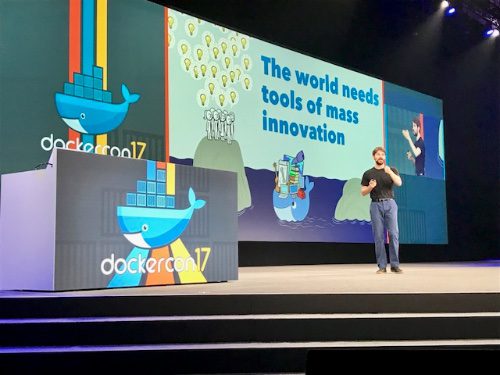Datamation content and product recommendations are
editorially independent. We may make money when you click on links
to our partners.
Learn More
AUSTIN — In a keynote at the DockerCon conference today, Docker founder Solomon Hykes re-iterated the project’s mission and explained the very basic model of how the project works. Hykes has said time and again that Docker’s mission is to create tools of mass innovation, which is a message he said again today.
He explained that the best tools do three things. First, they get out of the way. Second, they adapt to how developers want to work, and last they make the powerful, simple.
Cloud Storage and Backup Benefits
Protecting your company’s data is critical. Cloud storage with automated backup is scalable, flexible and provides peace of mind. Cobalt Iron’s enterprise-grade backup and recovery solution is known for its hands-free automation and reliability, at a lower cost. Cloud backup that just works.
SCHEDULE FREE CONSULT/DEMO
When it comes to development success, Hykes said that accelerating the development cycle is a primary attribute.
“The faster the development loop, the more things you can build,” Hykes said. “Our job is to remove friction in the development cycle.”
Once Docker has built a tool, the development process follows a simple iterative model. Hykes said that Docker releases something, developers complain about it, or note something is missing. The second step in the process is that Docker fixes whatever it is the developers were complaining about. The third step is to go back and repeat the first two steps – again and again.

Solomon Hykes at DockerCon.
“That’s all we do at Docker,” Hykes said. “We make lists of details and keep fixing things.”
Hykes said that developers do notice the details which is why Docker pays attention, listens and does the best it can to fix issues.
To that end, new releases of Docker fix issues that users have had in the past. One challenge cited by Hykes is that developers have said that Docker image are too large. To solve that problem, an upcoming Docker release will have a multi-stage build process, that enable the composition of smaller images.
Developers have also been using docker on the desktop and want to easily be able to move what they build to the cloud in a seamless manner. To that end, Docker is has a new desktop to cloud capability, to solve that challenge.
Docker is not also changing the way it builds tools, moving from a monolithic model and a single project, to hundreds or projects and a common assembly model for components. It’s all part of figuring out how to scale Docker as a project and as a community as well.
Hykes understand that Docker isn’t just for hobbyist anymore and it is increasingly becoming a mainstream technology.
“With mainstream adoption, comes great responsibilities, “Hykes said.
Sean Michael Kerner is a senior editor at Datamation and InternetNews.com. Follow him on Twitter @TechJournalist.
-
Ethics and Artificial Intelligence: Driving Greater Equality
FEATURE | By James Maguire,
December 16, 2020
-
AI vs. Machine Learning vs. Deep Learning
FEATURE | By Cynthia Harvey,
December 11, 2020
-
Huawei’s AI Update: Things Are Moving Faster Than We Think
FEATURE | By Rob Enderle,
December 04, 2020
-
Keeping Machine Learning Algorithms Honest in the ‘Ethics-First’ Era
ARTIFICIAL INTELLIGENCE | By Guest Author,
November 18, 2020
-
Key Trends in Chatbots and RPA
FEATURE | By Guest Author,
November 10, 2020
-
Top 10 AIOps Companies
FEATURE | By Samuel Greengard,
November 05, 2020
-
What is Text Analysis?
ARTIFICIAL INTELLIGENCE | By Guest Author,
November 02, 2020
-
How Intel’s Work With Autonomous Cars Could Redefine General Purpose AI
ARTIFICIAL INTELLIGENCE | By Rob Enderle,
October 29, 2020
-
Dell Technologies World: Weaving Together Human And Machine Interaction For AI And Robotics
ARTIFICIAL INTELLIGENCE | By Rob Enderle,
October 23, 2020
-
The Super Moderator, or How IBM Project Debater Could Save Social Media
FEATURE | By Rob Enderle,
October 16, 2020
-
Top 10 Chatbot Platforms
FEATURE | By Cynthia Harvey,
October 07, 2020
-
Finding a Career Path in AI
ARTIFICIAL INTELLIGENCE | By Guest Author,
October 05, 2020
-
CIOs Discuss the Promise of AI and Data Science
FEATURE | By Guest Author,
September 25, 2020
-
Microsoft Is Building An AI Product That Could Predict The Future
FEATURE | By Rob Enderle,
September 25, 2020
-
Top 10 Machine Learning Companies 2021
FEATURE | By Cynthia Harvey,
September 22, 2020
-
NVIDIA and ARM: Massively Changing The AI Landscape
ARTIFICIAL INTELLIGENCE | By Rob Enderle,
September 18, 2020
-
Continuous Intelligence: Expert Discussion [Video and Podcast]
ARTIFICIAL INTELLIGENCE | By James Maguire,
September 14, 2020
-
Artificial Intelligence: Governance and Ethics [Video]
ARTIFICIAL INTELLIGENCE | By James Maguire,
September 13, 2020
-
IBM Watson At The US Open: Showcasing The Power Of A Mature Enterprise-Class AI
FEATURE | By Rob Enderle,
September 11, 2020
-
Artificial Intelligence: Perception vs. Reality
FEATURE | By James Maguire,
September 09, 2020
SEE ALL
CLOUD ARTICLES








